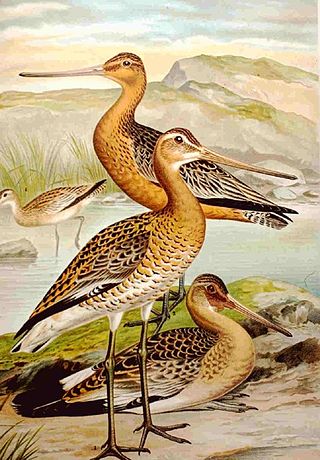Related Research Articles
Genus is a taxonomic rank used in the biological classification of living and fossil organisms as well as viruses. In the hierarchy of biological classification, genus comes above species and below family. In binomial nomenclature, the genus name forms the first part of the binomial species name for each species within the genus.

In mathematics, genus has a few different, but closely related, meanings. Intuitively, the genus is the number of "holes" of a surface. A sphere has genus 0, while a torus has genus 1.

Barn-owls are one of the two families of owls, the other being the true owls or typical owls, Strigidae. They are medium to large owls with large heads and characteristic heart-shaped faces. They have long, strong legs with powerful talons. They also differ from the Strigidae in structural details relating in particular to the sternum and feet.

Flaviviridae is a family of enveloped positive-strand RNA viruses which mainly infect mammals and birds. They are primarily spread through arthropod vectors. The family gets its name from the yellow fever virus; flavus is Latin for "yellow", and yellow fever in turn was named because of its propensity to cause jaundice in victims. There are 89 species in the family divided among four genera. Diseases associated with the group include: hepatitis (hepaciviruses), hemorrhagic syndromes, fatal mucosal disease (pestiviruses), hemorrhagic fever, encephalitis, and the birth defect microcephaly (flaviviruses).

The bulbuls are members of a family, Pycnonotidae, of medium-sized passerine songbirds, which also includes greenbuls, brownbuls, leafloves, and bristlebills. The family is distributed across most of Africa and into the Middle East, tropical Asia to Indonesia, and north as far as Japan. A few insular species occur on the tropical islands of the Indian Ocean. There are 166 species in 32 genera. While different species are found in a wide range of habitats, the African species are predominantly found in rainforest, whereas Asian bulbuls are predominantly found in more open areas.

In mathematics, particularly in complex analysis, a Riemann surface is a one-dimensional complex manifold.

The Gruiformes are an order containing a considerable number of living and extinct bird families, with a widespread geographical diversity. Gruiform means "crane-like".

A spirochaete or spirochete is a member of the phylum Spirochaetota, which contains distinctive diderm (double-membrane) gram-negative bacteria, most of which have long, helically coiled cells. Spirochaetes are chemoheterotrophic in nature, with lengths between 3 and 500 μm and diameters around 0.09 to at least 3 μm.

Apes are a clade of Old World simians native to sub-Saharan Africa and Southeast Asia, which together with its sister group Cercopithecidae form the catarrhine clade, cladistically making them monkeys. Apes do not have tails due to a mutation of the TBXT gene. In traditional and non-scientific use, the term ape can include tailless primates taxonomically considered Cercopithecidae, and is thus not equivalent to the scientific taxon Hominoidea. There are two extant branches of the superfamily Hominoidea: the gibbons, or lesser apes; and the hominids, or great apes.

The godwits are a group of four large, long-billed, long-legged and strongly migratory waders of the bird genus Limosa. Their long bills allow them to probe deeply in the sand for aquatic worms and molluscs. In their winter range, they flock together where food is plentiful. They frequent tidal shorelines, breeding in northern climates in summer and migrating south in winter. A female bar-tailed godwit made a flight of 29,000 km (18,000 mi), flying 11,680 kilometres (7,260 mi) of it without stopping. In 2020 a male bar-tailed godwit flew about 12,200 kilometres (7,600 mi) non-stop in its migration from Alaska to New Zealand, previously a record for avian non-stop flight. In October 2022, a 5 month old, male bar-tailed godwit was tracked from Alaska to Tasmania, a trip that took 11 days, and recorded a non-stop flight of 8,400 miles (13,500 km).

In mathematics, an affine algebraic plane curve is the zero set of a polynomial in two variables. A projective algebraic plane curve is the zero set in a projective plane of a homogeneous polynomial in three variables. An affine algebraic plane curve can be completed in a projective algebraic plane curve by homogenizing its defining polynomial. Conversely, a projective algebraic plane curve of homogeneous equation h(x, y, t) = 0 can be restricted to the affine algebraic plane curve of equation h(x, y, 1) = 0. These two operations are each inverse to the other; therefore, the phrase algebraic plane curve is often used without specifying explicitly whether it is the affine or the projective case that is considered.

Spironemidae is a family of heterotrophic flagellates, in the group Hemimastigophora. They vary in size and shape from the ellipsoid Hemimastix amphikineta to the vermiform Spironema terricola, and are united by the possession of two rows of cilia, called kineties.
Wyleyia is an extinct genus of birds, containing a single species, Wyleyia valdensis, known from the early Cretaceous period of Sussex, England. The genus is known from a single specimen, a damaged right humerus. It was named to honor J. F. Wyley, who found the specimen in Weald Clay deposits of Henfield in Sussex (England). The specific name valdensis means "from the Weald".

The brushtail possums are the members of the genus Trichosurus in the Phalangeridae, a family of marsupials. They are native to Australia and some small nearby islands. Unique among marsupials, they have shifted the hypaxial muscles from the epipubic to the pelvis, much like in placental muscles, meaning that their breathing cycle is more similar to the latter than to that of other non-eutherian mammals. In general, they are more terrestrially oriented than other possums, and in some ways might parallel primates.

Banna virus (BAV) is a virus belonging to Reoviridae, a family of segmented, non-enveloped, double-stranded RNA viruses. It is an arbovirus, being primarily transmitted to humans from the bite of infected mosquitoes of the genus Culex. Pigs and cattle have also been shown to become infected. The most common symptom of infection is fever, but in some cases encephalitis may occur. There is no specific treatment for infection, so treatment is aimed at alleviating the severity of symptoms until the immune system has cleared the infection.
Nonlabens antarcticus is a Gram-negative, strictly aerobic, psychrophilic and rod-shaped bacterium from the genus of Nonlabens which has been isolated from the core of a glacier from the King George Island.
Nonlabens marina is a Gram-negative, aerobic and rod-shaped bacterium from the genus of Nonlabens which has been isolated from seawater from the Pacific Ocean.
Nonlabens ulvanivorans is a Gram-negative, strictly aerobic, rod-shaped, chemoorganotrophic and non-motile bacterium from the genus of Nonlabens which has been isolated from the faeces of the sea slug Aplysia punctata.
Nonlabens xiamenensis is a Gram-negative, rod-shaped and non-motile bacterium from the genus of Nonlabens which has been isolated from seawater from the coast of Xiamen Island.
Nonlabens xylanidelens is a bacterium from the genus of Nonlabens.
References
- 1 2 3 4 5 6 7 8 9 10 11 12 13 14 15 16 17 18 19 "Genus: Nonlabens". LPSN.DSMZ.de.
- ↑ Parte, Aidan; Krieg, Noel R.; Ludwig, Wolfgang; Whitman, William B.; Hedlund, Brian P.; Paster, Bruce J.; Staley, James T.; Ward, Naomi; Brown, Daniel (4 February 2011). Bergey's Manual of Systematic Bacteriology: Volume 4: The Bacteroidetes, Spirochaetes, Tenericutes (Mollicutes), Acidobacteria, Fibrobacteres, Fusobacteria, Dictyoglomi, Gemmatimonadetes, Lentisphaerae, Verrucomicrobia, Chlamydiae, and Planctomycetes. Springer Science & Business Media. p. 248. ISBN 978-0-387-68572-4.